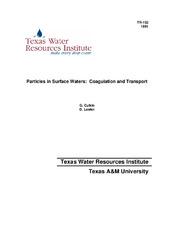| dc.creator | Culkin, Gerald W. | |
| dc.creator | Lawler, Desmond F. | |
| dc.date.accessioned | 2007-11-30T21:41:29Z | |
| dc.date.available | 2007-11-30T21:41:29Z | |
| dc.date.issued | 1991-08 | |
| dc.identifier.uri | https://hdl.handle.net/1969.1/6181 | |
| dc.description.abstract | Conventional water quality assessment and simulation of particles in natural waters focus on bulk concentrations of the suspended solid phase. These analyses rely directly or indirectly on a linear, 'average particle' approach to describe processes that are nonlinear and highly size-dependent.
Size-dependent transport and transformation mechanisms were simulated in this research to identify conditions in which coagulation is important. Explicit finite difference schemes for two-dimensional, laterally-averaged, unsteady particle transport were developed to approximate the size-dependent particle transport processes, which included advection, dispersion, and settling. Coupled exchange of discrete particles between the water column and sediment bed was modeled using size-dependent particle sedimentation and resuspension. Simultaneous particle-particle flocculation was integrated over time in parallel with transport.
Model simulations of systems with idealized morphometry and forcing provided greater insight to competing processes that drive particle behavior in natural systems. Application of the model to a real system gave plausible results and suggested explanations for observed conditions. | en |
| dc.language.iso | en_US | |
| dc.publisher | Texas Water Resources Institute | |
| dc.relation.ispartofseries | TR-152; | |
| dc.relation.ispartofseries | TR-xxx; | |
| dc.title | Particles in Surface Waters: Coagulation and Transport | en |
| dc.type | Technical Report | en |


